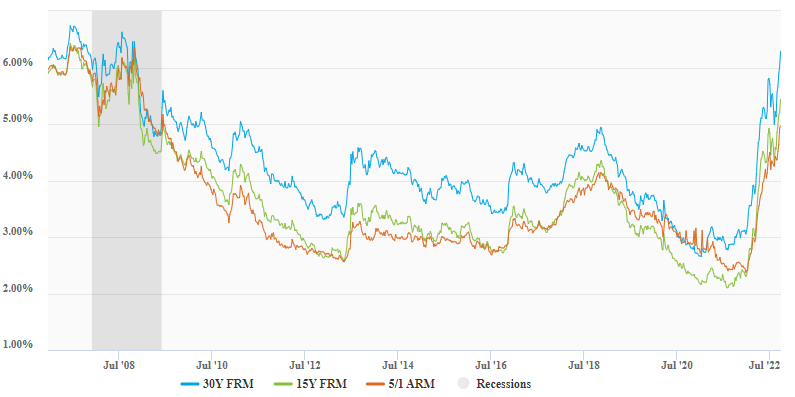Wild currency moves and rapidly rising interest rates have added to the economic challenges consumers face. But how exactly do central banks affect your mortgage and what does the future hold? And as a homeowner, how can you navigate higher rates?
In September alone, the Swiss National Bank (SNB), the US Federal Reserve (Fed), and the European Central Bank (ECB) all raised their benchmark interest rates by 0.75%. The rapid ascent of interest rates in the US and Europe to combat inflation is marking the end of decade-long ultra-loose monetary policies, which have been accompanied by rapid gains in asset prices, funded by cheap borrowing costs. And along with it, lower mortgage costs.
Rising mortgage rates
While central banks do not set mortgage rates directly, these are largely based on the interest rates set by central banks, which fluctuate.
Below are the mortgage rates for the US which have climbed to their highest level since 2008.
 Primary mortgage market survey, FreddieMac - US weekly average as of 22.09.2022.
Primary mortgage market survey, FreddieMac - US weekly average as of 22.09.2022.
In Switzerland, mortgage rates hover around 3% for fixed-interest mortgages for maturities of 3-10 years and closer to 3.5% for longer maturities. It’s a drastic increase from a level of below 1% a year ago, while the SNB still had interest rates stuck at -0.75%, versus +0.5% currently.
How does it work?
Rising interest rates generally increase mortgage rates, making it more expensive for new homeowners to service their loans. Existing homeowners may also face higher mortgage rates when in need of re-financing their mortgage. Homeowners with floating interest rates mortgages will also naturally face higher costs as interest rates rise.
Consequently, higher mortgage rates make it more difficult for would-be homeowners to afford mortgages. It can have the effect of adding pressure on rent prices as more people are willing to rent and the effect of lowering the demand for house prices as the higher mortgage costs price out would-be buyers.
What does the future hold?
In their efforts to bring inflation down, central bankers are embarking on the tough choice of cooling the economy. However, the consequences could be that economic pain spreads to the housing market, both for homeowners facing higher mortgage costs and renters finding it more difficult to find a home as demand increases.
In the thesis that central bankers succeed in tackling inflation, it is possible that interest rates come back down in the coming years, helping to alleviate some of the pressure from higher borrowing costs.
In the meantime, consumers face the difficult dilemma of assessing whether, after such a rapid rise, it makes sense to lock in currently high mortgage rates, or if interest rates could come back down. The reality is more nuanced for some markets, in which the demand for buying houses is so strong that some buyers fund it almost entirely with cash, making the debt servicing costs negligible. For example, nearly a third of buyers in the US bought homes in cash in July, helping dodge the surging mortgage rates which crossed 6% (30-year in USD) for the first time since 2008. In that sense, in Switzerland, it could be likely that more buyers consider withdrawing part of their retirement accounts early to alleviate the burden of higher mortgage rates.
How could homeowners navigate higher rates?

- Negotiate – While higher mortgage costs make it more expensive to service the debt, demand for buying houses is rapidly cooling, and so buyers could have the upper hand to negotiate. Shopping around and negotiating mortgage rates could also be an effective strategy to lessen the mortgage bill. Providers may be more willing to negotiate given the cooling market and higher rates.
- Remain flexible – With rates having risen rapidly to near a decade-high, a strategy could be to diversify mortgage maturities to remain flexible to take advantage of potentially lower rates in the future. One way to do this is to opt for short maturities or floating interest-rates mortgages, in which case the mortgage payments could be reduced in the case for example a severe economic slump causes central banks to cut interest rates, in which mortgage rates would likely follow. For a prudent approach, buyers may want to diversify maturities to spread the risk.
- Use cash – Bringing more equity to the home purchase could alleviate the cost of servicing a large mortgage. To do that, opting for shorter mortgage maturities or larger monthly payments could over time reduce the burden of paying interests.
Conclusion
The rapid ascent of mortgage rates will certainly make mortgages more expensive, but it could help cool down property prices for prospective buyers. Future mortgage rates could come down together with interest rates if central bankers are successful in rapidly lowering inflation. Homeowners may wish to opt for smaller mortgages, negotiate, diversify in maturities, and remain flexible for opportunities of potentially lower rates in the future.





